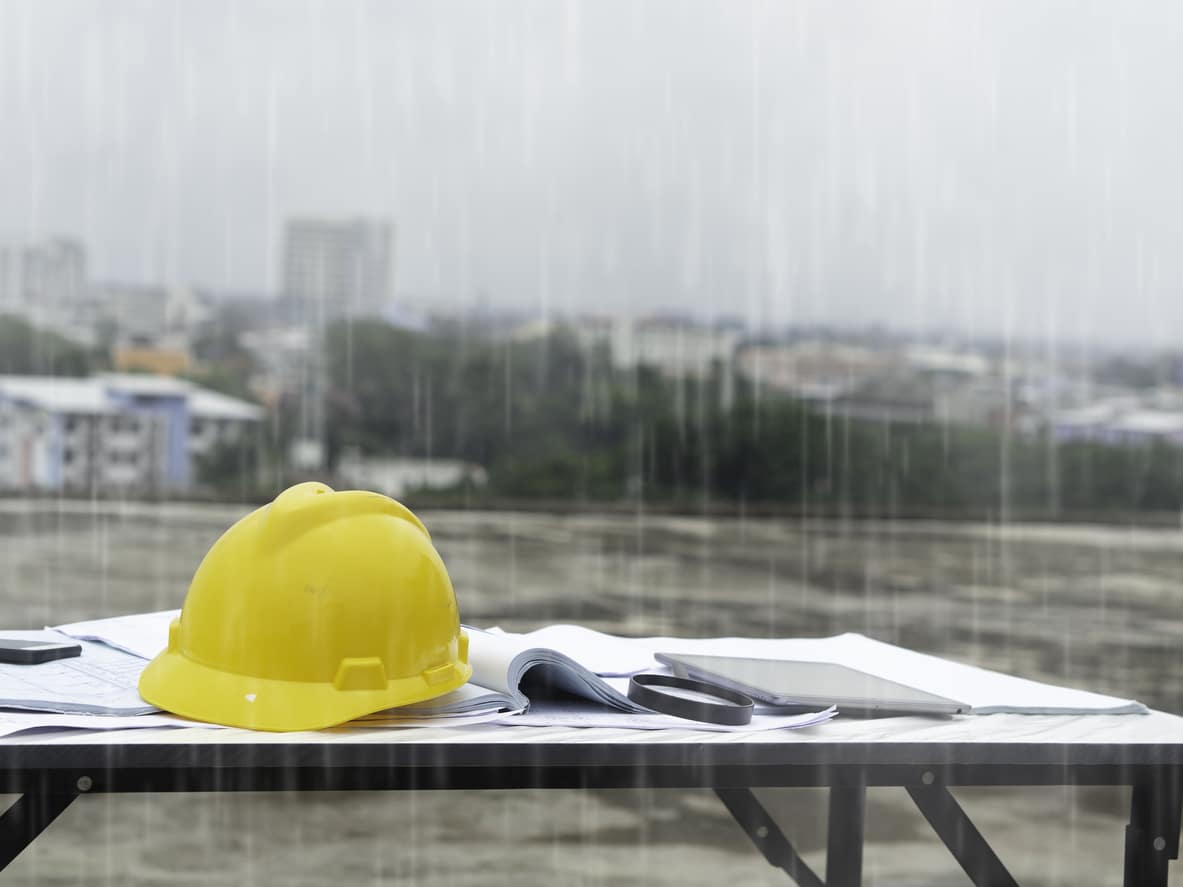Have you ever wondered how weather conditions affect your work on the construction site? What if a sudden rainstorm or extreme heat halted the entire project? In construction, weather is a powerful factor that can impact the timeline, budget, and safety of your projects. So, how can construction workers and project managers prepare for and mitigate the challenges posed by unpredictable weather?
The Unpredictable Impact of Weather on Construction Work
Weather is one of the most unpredictable variables on a construction site. From torrential downpours to extreme heatwaves or freezing temperatures, weather conditions can halt work, damage materials, or even pose risks to worker safety. Construction sites are often at the mercy of the elements, and delays or accidents caused by weather can lead to significant financial losses.
But how can construction professionals prepare for the impact of weather on construction work and minimize its disruption? By understanding how weather conditions affect various aspects of construction work and adopting proactive strategies, construction companies can safeguard their projects from costly setbacks. In this article, we will explore the specific ways weather influences construction work and provide actionable tips on how to prepare for the challenges it presents.
How Weather Affects Construction Work: A Closer Look
Weather plays a crucial role in determining how efficiently and safely construction projects are completed. Extreme weather can cause significant disruptions to workers, materials, equipment, and the overall project schedule. Here are some key ways weather impacts construction work:
1. Rain and Flooding
Rain is one of the most common weather-related disruptions in construction. It can delay work, especially in tasks such as excavation, concrete pouring, or outdoor structural work. Heavy rainfall can lead to flooding, which could damage equipment and materials, and create dangerous working conditions.
- Delayed Work Schedules: Wet conditions make it difficult to perform many construction activities. For example, pouring concrete in the rain can compromise the material’s integrity, and workers may not be able to operate heavy machinery on slippery surfaces.
- Flooding Risks: Excessive rainfall can cause site flooding, which may damage machinery, materials, and the surrounding environment, leading to costly repairs and project delays.
Preparation Tips:
- Use weather forecasting tools to anticipate rainstorms and plan activities accordingly.
- Create drainage systems or berms around the site to redirect water and prevent flooding.
- Equip the site with covers to protect materials and machinery from rain damage.
2. Extreme Heat and Sun Exposure
Working in extreme heat poses significant health risks for construction workers, such as heat exhaustion and heat stroke. On top of this, high temperatures can affect materials, causing them to warp, crack, or deteriorate, which can delay the project.
- Health Hazards for Workers: Heat-related illnesses, such as dehydration and heat stroke, can lead to worker fatigue, reduced productivity, or even serious injuries.
- Material Deterioration: Some materials, such as asphalt, concrete, and adhesives, may not perform optimally in high temperatures. For example, asphalt can soften in extreme heat, making it more difficult to work with.
Preparation Tips:
- Schedule work during cooler times of the day, such as early mornings or late afternoons.
- Provide workers with hydration stations and encourage frequent water breaks.
- Use protective clothing such as cooling vests, hats, and sunscreen to shield workers from heat and sun exposure.
3. Cold Weather and Snow
Cold temperatures, snow, and ice present unique challenges for construction teams. Frozen ground can delay excavation, and snow can cover critical areas of the site, making it difficult to navigate or continue work. In addition, freezing temperatures can cause materials to freeze, making it difficult to use certain construction products.
- Frozen Ground: When the ground freezes, excavation becomes nearly impossible. In some cases, this can delay project timelines or require the use of more expensive equipment.
- Icy Surfaces: Snow and ice can create slippery conditions, increasing the risk of workplace accidents. Workers may also experience frostbite or hypothermia in extreme cold.
Preparation Tips:
- Use heaters to warm materials such as concrete before application to prevent freezing.
- Use ice and snow management practices, such as salting walkways and applying non-slip surfaces.
- Schedule outdoor work during the warmer part of the day or consider indoor work options when temperatures are too low.
4. Wind and Storms
High winds and storms are a serious hazard on construction sites, especially for workers who are high up on scaffolding or roofs. Strong winds can also damage scaffolding, equipment, and temporary structures, leading to both safety risks and significant delays.
- Safety Risks: Workers on elevated platforms are at risk of being blown off or exposed to falling debris. High winds can also interfere with the operation of cranes and heavy machinery.
- Structural Damage: Windstorms can knock down scaffolding, damage tarps, or destroy partially completed structures, causing costly delays and repairs.
Preparation Tips:
- Secure scaffolding, materials, and equipment to prevent damage from high winds.
- Monitor weather forecasts to anticipate storms and halt work when necessary.
- Provide workers with proper fall protection gear and ensure all equipment is in safe working condition.
Best Practices to Prepare for Weather Disruptions in Construction
Now that we’ve explored the specific ways in which weather impacts construction work, let’s discuss the best practices to prepare for these disruptions:
1. Use Technology to Forecast Weather and Plan Accordingly
Construction teams can use modern weather forecasting tools and software to predict adverse weather conditions well in advance. This proactive approach allows project managers to adjust the schedule and allocate resources accordingly.
- Mobile Weather Apps: Use apps that provide real-time weather data and alerts, helping project managers and workers stay updated on any sudden changes.
- Weather Stations on Site: Installing weather stations at construction sites can help monitor real-time weather conditions, such as wind speed and temperature, to ensure the site is safe for work.
2. Invest in Protective Equipment and Gear
Protective gear is essential to keep workers safe in extreme conditions. Employers should invest in high-quality gear designed to protect workers from the harsh effects of heat, cold, rain, and wind.
- Heat and Cold Protective Gear: Ensure that workers have access to cooling vests, breathable clothing, insulated boots, and gloves suited for extreme conditions.
- Safety Gear for Wet Conditions: Provide waterproof clothing, rubber boots, and non-slip shoes to protect workers from rain or snow.
- Weatherproof Equipment: Invest in machinery and equipment that are designed to function well in various weather conditions.
3. Establish a Contingency Plan for Weather Delays
Having a contingency plan in place ensures that workers and managers are prepared when weather disrupts construction progress. This plan should include steps for rescheduling work, redirecting tasks, or pausing activities if necessary.
- Adjust Schedules: When extreme weather is predicted, plan to move indoor or weather-resistant tasks forward, ensuring that productivity remains high.
- Plan for Delays: Anticipate delays caused by weather, and factor them into your project timelines. This prevents major setbacks when the inevitable disruption happens.
4. Safety Training for Workers
Safety is paramount in any working environment, but it’s especially critical in harsh weather conditions. Construction companies should provide regular training sessions to ensure that workers are aware of the risks posed by extreme weather and know how to protect themselves.
- Heat and Cold Safety Training: Educate workers on the signs of heat exhaustion, frostbite, and hypothermia, and train them on how to respond in emergencies.
- Weather-Related Safety Drills: Conduct mock drills for weather-related emergencies, such as evacuations during storms or heatstroke responses.
Top Companies Hiring in the Construction Industry
As the construction industry grows in both Canada and the USA, many leading companies are actively hiring workers to manage the demands of the industry. Below are some companies that are seeking skilled workers in this field:
- SNC-Lavalin (Canada)
SNC-Lavalin is a global leader in engineering and construction, offering opportunities for construction professionals in all weather conditions.
Apply Now at SNC-Lavalin - Bechtel (USA)
Bechtel is actively hiring for construction roles that deal with weather-sensitive environments, ensuring that safety standards are maintained.
Apply Now at Bechtel - PCL Construction (Canada & USA)
PCL Construction offers job opportunities for workers in both cold and hot climates, with a focus on weather-adaptive practices.
Apply Now at PCL Construction - EllisDon (Canada)
Known for their commitment to safety and quality, EllisDon provides comprehensive training for weather-related challenges.
Apply Now at EllisDon
Stay Safe and Productive in All Weather Conditions
Working in extreme heat and cold is part of the job in construction, but with the right preparation and safety measures, workers can minimize the risks associated with these conditions. By following best practices, utilizing technology, and investing in the right gear, construction teams can maintain productivity while keeping everyone safe.
Whether it’s adjusting schedules to accommodate weather disruptions or providing workers with the tools they need to work safely in extreme temperatures, construction managers and workers must prioritize preparation. Implementing these strategies will not only ensure safety but will also help keep projects on track and within budget.






Leave feedback about this